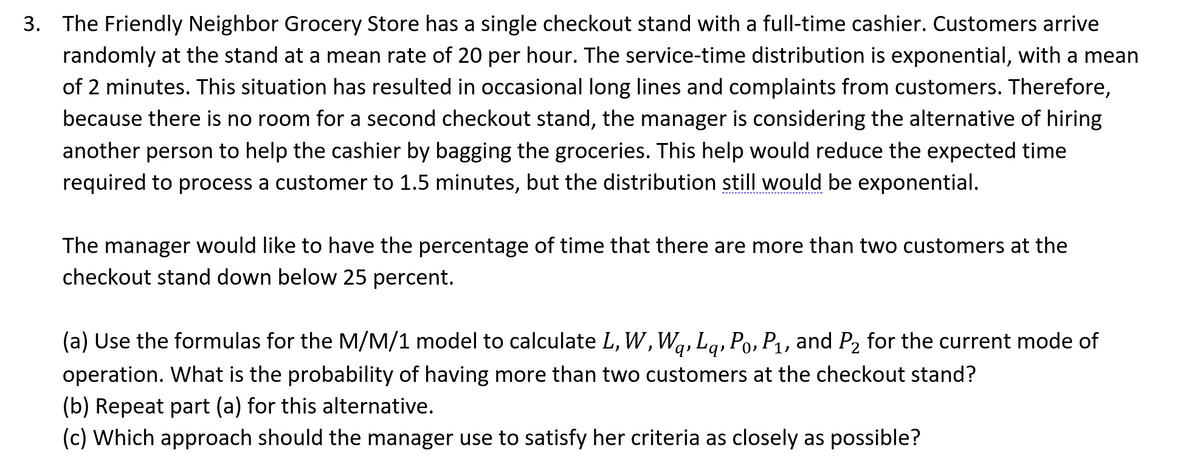The Friendly Neighbor Grocery Store has a single checkout stand with a full-time cashier. Customers arrive randomly at the stand at a mean rate of 20 per hour. The service-time distribution is exponential, with a mear of 2 minutes. This situation has resulted in occasional long lines and complaints from customers. Therefore, because there is no room for a second checkout stand, the manager is considering the alternative of hiring another person to help the cashier by bagging the groceries. This help would reduce the expected time required to process a customer to 1.5 minutes, but the distribution still would be exponential. The manager would like to have the percentage of time that there are more than two customers at the checkout stand down below 25 percent. (a) Use the formulas for the M/M/1 model to calculate L, W, Wa, La, Po, P₁, and P₂ for the current mode of operation. What is the probability of having more than two customers at the checkout stand? (b) Repeat part (a) for this alternative. (c) Which approach should the manager use to satisfy her criteria as closely as possible?
The Friendly Neighbor Grocery Store has a single checkout stand with a full-time cashier. Customers arrive randomly at the stand at a mean rate of 20 per hour. The service-time distribution is exponential, with a mear of 2 minutes. This situation has resulted in occasional long lines and complaints from customers. Therefore, because there is no room for a second checkout stand, the manager is considering the alternative of hiring another person to help the cashier by bagging the groceries. This help would reduce the expected time required to process a customer to 1.5 minutes, but the distribution still would be exponential. The manager would like to have the percentage of time that there are more than two customers at the checkout stand down below 25 percent. (a) Use the formulas for the M/M/1 model to calculate L, W, Wa, La, Po, P₁, and P₂ for the current mode of operation. What is the probability of having more than two customers at the checkout stand? (b) Repeat part (a) for this alternative. (c) Which approach should the manager use to satisfy her criteria as closely as possible?
Practical Management Science
6th Edition
ISBN:9781337406659
Author:WINSTON, Wayne L.
Publisher:WINSTON, Wayne L.
Chapter12: Queueing Models
Section12.5: Analytic Steady-state Queueing Models
Problem 30P
Related questions
Question

Transcribed Image Text:3. The Friendly Neighbor Grocery Store has a single checkout stand with a full-time cashier. Customers arrive
randomly at the stand at a mean rate of 20 per hour. The service-time distribution is exponential, with a mean
of 2 minutes. This situation has resulted in occasional long lines and complaints from customers. Therefore,
because there is no room for a second checkout stand, the manager is considering the alternative of hiring
another person to help the cashier by bagging the groceries. This help would reduce the expected time
required to process a customer to 1.5 minutes, but the distribution still would be exponential.
The manager would like to have the percentage of time that there are more than two customers at the
checkout stand down below 25 percent.
(a) Use the formulas for the M/M/1 model to calculate L, W, W₁, Lq, Po, P₁, and P₂ for the current mode of
operation. What is the probability of having more than two customers at the checkout stand?
(b) Repeat part (a) for this alternative.
(c) Which approach should the manager use to satisfy her criteria as closely as possible?
Expert Solution
This question has been solved!
Explore an expertly crafted, step-by-step solution for a thorough understanding of key concepts.
This is a popular solution!
Trending now
This is a popular solution!
Step by step
Solved in 4 steps with 4 images

Recommended textbooks for you

Practical Management Science
Operations Management
ISBN:
9781337406659
Author:
WINSTON, Wayne L.
Publisher:
Cengage,

Practical Management Science
Operations Management
ISBN:
9781337406659
Author:
WINSTON, Wayne L.
Publisher:
Cengage,